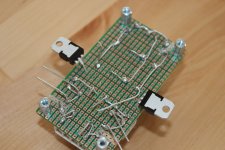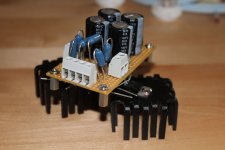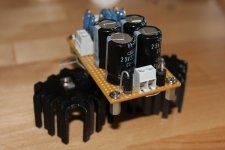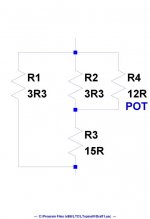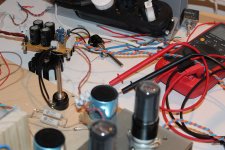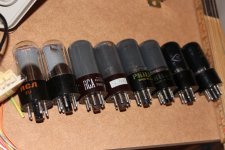time for beer
ook electronic

I would join you but the solder is hot😀
Cheers mate!
I would join you but the solder is hot😀
Cheers mate!
A metaxa free build session 😕😕😕.
Usually worx😉
This is so hard to calculate in terms of unknown tube filament data so I think Ill just quick rig something and try a bunch.
Doing the Colvern plus extra series resistor parallell to 3,3 will be a close call in wattage.
This is so hard to calculate in terms of unknown tube filament data so I think Ill just quick rig something and try a bunch.
Doing the Colvern plus extra series resistor parallell to 3,3 will be a close call in wattage.
Usually worx😉
This is so hard to calculate in terms of unknown tube filament data so I think Ill just quick rig something and try a bunch.
Doing the Colvern plus extra series resistor parallell to 3,3 will be a close call in wattage.
The Colvern pots takes some abuse before they fail.
You can´t be dissipating more then a watt ?
Say 12R pass 0,15 A which is not impossible if a tube draws 0,5 or some more even. 0,15 times 6,3 is 0,95 W so I SHOULD be within margins but its close.
Thing is, we dont really know how each and every tube acts when CSS fed. All I know thay acted very differently. I start with ZMs circuit and collect some data.
Thing is, we dont really know how each and every tube acts when CSS fed. All I know thay acted very differently. I start with ZMs circuit and collect some data.
Say 12R pass 0,15 A which is not impossible if a tube draws 0,5 or some more even. 0,15 times 6,3 is 0,95 W so I SHOULD be within margins but its close.
Thing is, we dont really know how each and every tube acts when CSS fed. All I know thay acted very differently. I start with ZMs circuit and collect some data.
If you burn the Colverns i can supply the bigbrother.
They´re in the 3W range.
Next size bigger won´t fit the box 😀.
Hello insect lovers
The bug is now up and running and I have been running some samples. The schema is ZMs except for 10R pots and 18R series (R3).
I first ran it on 13R5 dummies and got between
5,82-5,93 and 5,84-5,95 volts (ch 1 and 2) by min/max on pot.
Then I dropped in a pair of RCA clearglass
5,86-6,09 and 5,98-6,14
RCA Black Anodes
5,43-5,61 and 5,51-5,68
Philips
6,01-6,23 and 5,71-5,91
Russian 6P6S
6,12-6,32 and 5,90-6,08
Well, what do we get out of that. At least I would like to be able to run different tubes in the same amp without having to open it and solder, so if running CSS on filaments I definately need a variable one.
Second I need a wider variation span. Almost 0,7 volts in difference between tubes is (only those few tested yet) is going to affect the sound to much for being acceptable for me.
The way to go might be to drop R2. That will put more current over the pot but make it more variable in current (and voltage).
Any suggestions/comments before I tear things apart?
The bug is now up and running and I have been running some samples. The schema is ZMs except for 10R pots and 18R series (R3).
I first ran it on 13R5 dummies and got between
5,82-5,93 and 5,84-5,95 volts (ch 1 and 2) by min/max on pot.
Then I dropped in a pair of RCA clearglass
5,86-6,09 and 5,98-6,14
RCA Black Anodes
5,43-5,61 and 5,51-5,68
Philips
6,01-6,23 and 5,71-5,91
Russian 6P6S
6,12-6,32 and 5,90-6,08
Well, what do we get out of that. At least I would like to be able to run different tubes in the same amp without having to open it and solder, so if running CSS on filaments I definately need a variable one.
Second I need a wider variation span. Almost 0,7 volts in difference between tubes is (only those few tested yet) is going to affect the sound to much for being acceptable for me.
The way to go might be to drop R2. That will put more current over the pot but make it more variable in current (and voltage).
Any suggestions/comments before I tear things apart?
Attachments
You can raise the value of R2 and lower the value of R3.
That vill give you a wider set span.
That vill give you a wider set span.
R2 6,8, R3 10? That will bring the average voltage up a bit also right? (Now R2 3,3 and R3 18R)
R2 6,8, R3 10? That will bring the average voltage up a bit also right? (Now R2 3,3 and R3 18R)
Going low on R3 gives you the chance to overfeed the poor tubes 😀.
If you go 12 and 12 you get a large span....
I will give it a try and sort out the breadboard a little so I can first go over some more tubes and then go on with the audio circuit testing.
Is the distance between CSS and filaments of any importance in this kind of application or can I just place it anywhere?
Is the distance between CSS and filaments of any importance in this kind of application or can I just place it anywhere?
I will give it a try and sort out the breadboard a little so I can first go over some more tubes and then go on with the audio circuit testing.
Is the distance between CSS and filaments of any importance in this kind of application or can I just place it anywhere?
Current is the same through the entire circuit so not the problems you have with voltage regulation.
So not sensitive to cable lenght.
Quick update. 12R series with 12R parallelled with the 10R pot gave greater span but not enough. The RCA Black Anodes spanned between 5,44-6,09 and the russkies between 6,09-6,7+. I need a bigger pot. Luckily Flathead is more well equipped then Mousers Central Stash🙂
Big dog from Japan seems to like BAs' Idea of damper diode after SS.
6moons audio reviews: Leben CS660P
"Hyodo San used a silicon diode instead of rectifier tube for its "high speed, large capacity, small consumption and small size". However, because the diode supplies a large voltage immediately after turning on power, a 6CJ3 "dumper tube" provides delayed ramp-up of the output tube voltages to warm the pentodes up gently and extend their operational life."
6moons audio reviews: Leben CS660P
"Hyodo San used a silicon diode instead of rectifier tube for its "high speed, large capacity, small consumption and small size". However, because the diode supplies a large voltage immediately after turning on power, a 6CJ3 "dumper tube" provides delayed ramp-up of the output tube voltages to warm the pentodes up gently and extend their operational life."
I`m a little curious here i see a lot of high fashion amps use crappy diodes with all kinds of elaborous snubbers.
If i have a CT transformer i go for a TO-220 double diode of a more modern type and it performs excellent without anything.
What am i missing here ?
If i have a CT transformer i go for a TO-220 double diode of a more modern type and it performs excellent without anything.
What am i missing here ?
I was posting that more as a comment on Bas' idea of SS rectification with damper tube to slow ramp up. I think that is all the tube is for. T was intersting to me that I happened across it in a review of a well regarded amp. As i said earlier, I preferred SS, but being new to the game, I take that with a grain of salt. It is reasonable to believe that each has its merits. I do not know, just learning.
...... It is reasonable to believe that each has its merits........
exactly
- Home
- Amplifiers
- Tubes / Valves
- 6V6 line preamp

